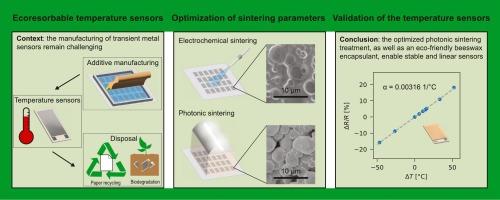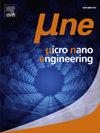Printed ecoresorbable temperature sensors for environmental monitoring
Abstract
Electronic waste has become a pressing issue, necessitating sustainable solutions for the disposal of electronic devices. While the development of environmentally degradable electronics has gained attention, the fabrication of stable and performant sensors from biodegradable materials remains challenging. We present printed degradable resistance temperature detectors (RTDs) based on the photonic sintering of a zinc microparticles ink on a cellulosic substrate. Efficient sintering is attained via a two-step process involving electrochemical oxide removal and pulsed light exposure using a xenon lamp. By optimizing the pulse energy and pulse count, we obtain highly linear zinc-based RTDs with a high temperature coefficient of resistance (TCR). The printed zinc reaches a TCR value of 3160 ppm/K, which represents about 80% of the value of the bulk material. The dynamic response of the sensors in a range from −20 to 40 °C closely matches the temperature signal recorded by a commercial sensor. The encapsulation of the screen-printed sensors on paper substrate with a biodegradable beeswax coating ensures protection against the interference of moisture. These printed RTDs, fully made of degradable materials, pave the way to the cost-effective manufacturing of eco-friendly yet performant sensors for environmental monitoring.


 求助内容:
求助内容: 应助结果提醒方式:
应助结果提醒方式:


